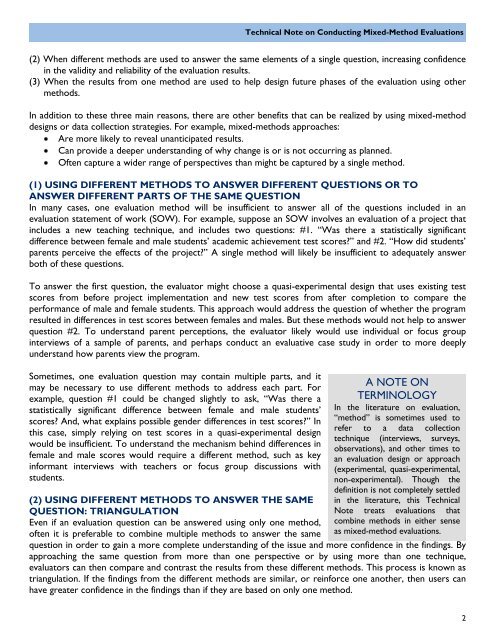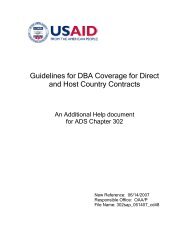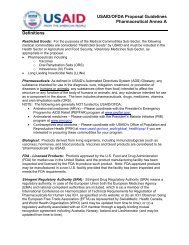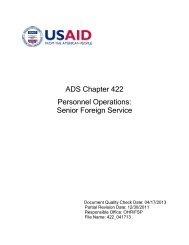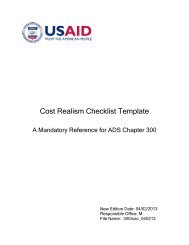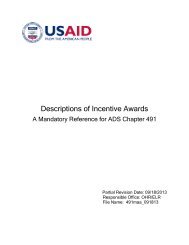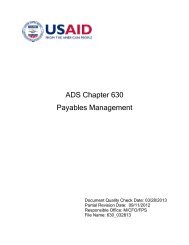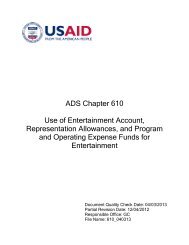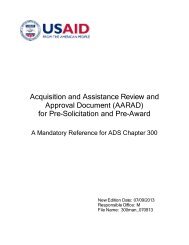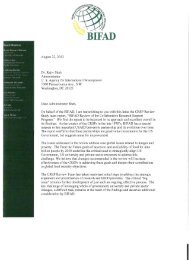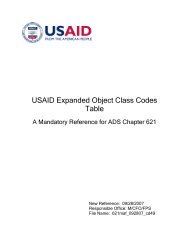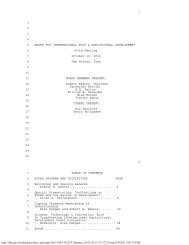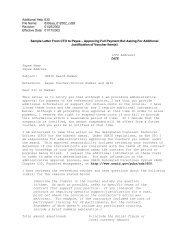Technical Note: Conducting Mixed Method Evaluations - usaid
Technical Note: Conducting Mixed Method Evaluations - usaid
Technical Note: Conducting Mixed Method Evaluations - usaid
Create successful ePaper yourself
Turn your PDF publications into a flip-book with our unique Google optimized e-Paper software.
<strong>Technical</strong> <strong>Note</strong> on <strong>Conducting</strong> <strong>Mixed</strong>-<strong>Method</strong> <strong>Evaluations</strong><br />
(2) When different methods are used to answer the same elements of a single question, increasing confidence<br />
in the validity and reliability of the evaluation results.<br />
(3) When the results from one method are used to help design future phases of the evaluation using other<br />
methods.<br />
In addition to these three main reasons, there are other benefits that can be realized by using mixed-method<br />
designs or data collection strategies. For example, mixed-methods approaches:<br />
Are more likely to reveal unanticipated results.<br />
Can provide a deeper understanding of why change is or is not occurring as planned.<br />
Often capture a wider range of perspectives than might be captured by a single method.<br />
(1) USING DIFFERENT METHODS TO ANSWER DIFFERENT QUESTIONS OR TO<br />
ANSWER DIFFERENT PARTS OF THE SAME QUESTION<br />
In many cases, one evaluation method will be insufficient to answer all of the questions included in an<br />
evaluation statement of work (SOW). For example, suppose an SOW involves an evaluation of a project that<br />
includes a new teaching technique, and includes two questions: #1. “Was there a statistically significant<br />
difference between female and male students’ academic achievement test scores?” and #2. “How did students’<br />
parents perceive the effects of the project?” A single method will likely be insufficient to adequately answer<br />
both of these questions.<br />
To answer the first question, the evaluator might choose a quasi-experimental design that uses existing test<br />
scores from before project implementation and new test scores from after completion to compare the<br />
performance of male and female students. This approach would address the question of whether the program<br />
resulted in differences in test scores between females and males. But these methods would not help to answer<br />
question #2. To understand parent perceptions, the evaluator likely would use individual or focus group<br />
interviews of a sample of parents, and perhaps conduct an evaluative case study in order to more deeply<br />
understand how parents view the program.<br />
Sometimes, one evaluation question may contain multiple parts, and it<br />
may be necessary to use different methods to address each part. For<br />
example, question #1 could be changed slightly to ask, “Was there a<br />
statistically significant difference between female and male students’<br />
scores? And, what explains possible gender differences in test scores?” In<br />
this case, simply relying on test scores in a quasi-experimental design<br />
would be insufficient. To understand the mechanism behind differences in<br />
female and male scores would require a different method, such as key<br />
informant interviews with teachers or focus group discussions with<br />
students.<br />
(2) USING DIFFERENT METHODS TO ANSWER THE SAME<br />
QUESTION: TRIANGULATION<br />
Even if an evaluation question can be answered using only one method,<br />
often it is preferable to combine multiple methods to answer the same<br />
A NOTE ON<br />
TERMINOLOGY<br />
In the literature on evaluation,<br />
“method” is sometimes used to<br />
refer to a data collection<br />
technique (interviews, surveys,<br />
observations), and other times to<br />
an evaluation design or approach<br />
(experimental, quasi-experimental,<br />
non-experimental). Though the<br />
definition is not completely settled<br />
in the literature, this <strong>Technical</strong><br />
<strong>Note</strong> treats evaluations that<br />
combine methods in either sense<br />
as mixed-method evaluations.<br />
question in order to gain a more complete understanding of the issue and more confidence in the findings. By<br />
approaching the same question from more than one perspective or by using more than one technique,<br />
evaluators can then compare and contrast the results from these different methods. This process is known as<br />
triangulation. If the findings from the different methods are similar, or reinforce one another, then users can<br />
have greater confidence in the findings than if they are based on only one method.<br />
2


